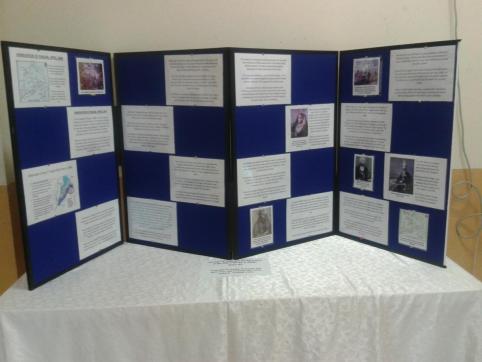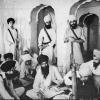Search the Community
Showing results for tags 'parchar'.
-
How Christianity is growing among Mazhabi Sikhs & Valmiki Hindus in Punjab’s villages Christianity is growing in Punjab, mirroring what states like Tamil Nadu experienced in the 1980s and 1990s. Small churches are springing up on the rooftops of many villages. SHUBHANGI MISRA 2 December, 2021 10:44 am IST A Catholic church in Fatehgarh Churian, Gurdaspur | Shubhangi Misra | ThePrint Text Size: A- A+ Amritsar/Gurdaspur: Atop a roof in an obscure gully in Fatehgarh Churian, a Pentecostal church is in full swing. “Rabba rabba rabba rabba, pita parmeshwar teri aatma rahe… rabba rabba rabba rabba rabba…” a young boy raps into the mic, boosted to its maximum volume, adding to the trippy and eerie mood. The pastor places his hand on the heads of disciples as they shake violently. Some faint, others cry. But all are waiting for a miracle. Christianity is growing in Punjab, mirroring what states like Tamil Nadu experienced in the 1980s and 1990s. Small churches are springing up on the rooftops of many villages in Gurdaspur. Tired of centuries of casteism and systemic oppression, many Dalits, belonging to the Mazhabi Sikh and Valmiki Hindu communities living in Punjab’s border belt, have started looking to Christianity in the hope of a dignified life and access to better education. Kamal Bakshi is the state president of the United Christian Front, a group that has committees in 8,000 of Punjab’s 12,000 villages. According to him, there are 600-700 churches in Amritsar and Gurdaspur districts that belong to four Christian denominations. He says 60-70 per cent of these have sprung up in the past five years. The Christian faith has co-opted many of the cultural markers of Punjab, from turbans to tappe. On YouTube, one can find Christian giddas (a folk dance), tappe (a musical form) and boliyan (sung couplets), and songs in praise of Jesus in Punjabi. The visuals show men and women singing these songs in a rural Punjabi setup. With 14 million views, one song goes, ‘Har mushkil de wich, mera Yeeshu mere naal naal hai. Baap wangu karda fikar, te maa wangu rakhda khyaal hai’ (Jesus is with me through all my problems. He worries for me like a father and cares for me like my mother). Some converts from Sikhism don’t discard their turbans. “Clothes don’t determine anyone’s religion. I have been wearing a turban since I was a young boy. Why should I take it off now that I am a Christian? It’s a part of my identity,” a devotee who does not wish to be named tells ThePrint. Devotees also enter churches after covering their heads, as is the practice in gurdwaras, although this mandate seems to apply only to women. A woman prays at a church in Fatehgarh Churian, Gurdaspur | Shubhangi Misra | ThePrint Names are a similar case. While most Christians in the state use the surname ‘Massih’ to indicate their allegiance to the Church, many don’t change their previous names. For them, there’s a reason not to change their names: To take advantage of reservation for Dalits, which isn’t available if they convert. This is also cited as the reason census figures invariably miss much of the Christian population in Punjab, which then leads to negligent representation of the demographic in state politics. It has also led to a debate on reservation in the state — are converted Dalits no longer marginalised? The current demand of Christian bodies in Punjab is 2 per cent reservation in government jobs and the setting up of a state minorities commission. Also read: Punjab’s Dalits are shifting state politics, flocking churches, singing Chamar pride Conversion in border villages, Sikh authorities irked Sixty-year-old Sukhwant Kaur has no one but Jesus. A resident of Dujowal village in Amritsar district, she lives in a one-room house made of bricks, with no stove to cook on and no family to cook for. The only adornments in her house are posters of Jesus. “The Christian faith has given me a sense of community, Jesus has got rid of negative energy from my life,” she says. Formerly a Mazhabi Sikh, she converted to Christianity because she liked going to church. Like Sukhwant, many Valmikis and Mazhabis living in Punjab’s border belt, in Amritsar, Gurdaspur and Ferozepur districts, have embraced the Christian faith. Sukhwant Kaur at her house in Dujowal village, Amritsar district | Shubhangi Misra | ThePrint ThePrint visited Dujowal, a village 2 kilometres from the Pakistan border, where about 30 per cent of the voters are Christian, according to sarpanch Samuel Massih. There are two gurdwaras in the village — along with two churches and a temple. Awan, another border village, is the largest in the Ajnala assembly constituency in Amritsar district, with a population of 10,000. It’s home to four churches of different denominations — Roman Catholic, and Protestant denominations including Pentecostals and the Salvation Army. This conversion to Christianity has irked the Shiromani Gurdwara Parbandhak Committee, the organisation responsible for managing gurdwaras across Punjab and several other states. The committee has launched initiatives to ‘counter’ Christian conversion. One such effort is the ‘Ghar Ghar Andar Dharamsaal’ campaign, where volunteers go door-to-door to spread the word of Sikhism. Recently, Giani Harpreet Singh, jathedar of the Akal Takht — the highest seat of earthly authority for Sikhs — alleged that Christians were converting Sikhs in border villages through force and by luring them with money. Also read: Not royalty nor father figure — Why Punjab’s 1st Dalit CM Channi is a ‘refreshing change’ No reservation, ‘missing’ from census Even though there is a growing Christian electorate in the state, the community has negligible representation in state politics. There hasn’t been a single Christian MLA elected to the Punjab Legislative Assembly since independence. This lack of representation affects Christians even at the panchayat level. Sukhwinder Massih, 25, a resident of Awan village, tells ThePrint, “In our village, the Christian vote is more than the Jatt (Sikh) vote. And yet, they don’t let us Christians or Mazhabis become members of the panchayat.” He adds, “Even if our candidate wins in the reserved seat, they don’t grant their tenure any legitimacy. If the Akalis win, there’s a Jatt sarpanch. If the Congress wins, then again a Jatt sarpanch. Nobody listens to us, they all try to oppress us.” According to the 2011 census, Christians make up a little over 2 per cent of the population of Amritsar district, and 7.68 per cent in Gurdaspur, the district where they are most concentrated. News reports peg the Christian vote share in Gurdaspur district at 17 to 20 per cent. In the 2019 Lok Sabha elections, the Aam Aadmi Party’s (AAP) Christian candidate in the Gurdaspur constituency, Peter Massih, was defeated, coming in third after the Bharatiya Janata Party’s (BJP) Sunny Deol and the Congress’s Sunil Jakhar. Sonu Jaffer, an AAP leader and president of the Christian Samaj Front, which has 1 lakh members in Punjab, says, “If any Christian ever gets a ticket, it’s only from Gurdaspur. This time, I’m demanding a ticket from Ajnala constituency in Amritsar district. There are about 43,000 Christian voters here.” Gurdaspur District Congress President Roshan Joseph praying at Sunday mass, attended by approximately 1,000 people | Shubhangi Misra | ThePrint Kamal Bakshi says there is gross undercounting of Christians in the census. “Even if a person embraces Christianity, they don’t change their names in official documents so they can take advantage of reservation benefits. Because of this, the Christian population is grossly undercounted. At least 23 per cent of Gurdaspur is Christian, and the figures must be similar in Amritsar too,” he claims. Many Christians feel ostracised because they aren’t entitled to reservation benefits, even though their socio-economic profile is similar to Mazhabis and Valmikis. Thirty-eight-year-old Monica from Fatehgarh Churian says she doesn’t understand why this is happening to her community. “Christians have to work harder for everything. Our community is among the poorest of the poor, and yet we don’t get any reservations. Why is it nobody wants to lend us an ear? You’re the first one who has ever come here and asked us what we want,” she tells ThePrint. According to Bakshi, 95 per cent of Christians in Punjab are converts, and an overwhelming majority come from Dalit backgrounds. Thus, the lack of reservation feels discriminatory. Other grassroots leaders share this sentiment. Roshan Massih, the Congress’s Gurdaspur district president, says, “Once a Dalit chooses to be a Christian, they stop getting any reservation benefits and face social ostracisation. So, people try to hide their identity, which is why government figures don’t reflect the correct number of Christians in the state. It’s discriminatory not to extend benefits reserved for the SC Sikh and Hindu community to Christians, who need it just as much.” Also read: Low enrolment & farmers ‘unpaid’ in Punjab’s ‘Pani Bachao, Paise Kamao’ scheme, but power saved Reasons for conversion A grandiose ‘Jatt’ gurdwara towering over a dilapidated ‘Dalit’ gurdwara is a common sight in Punjab’s villages. There are often two or three gurdwaras belonging to different castes, symptomatic of the deep-rooted nature of caste in the region. This can feel alienating, and the Church gives a sense of community. Daniel B. Das, director, socio-economic issues, Church of North India, tells ThePrint that “95 per cent of Christians in Punjab belong to the same class and the same previous caste, so there’s absolutely no space for discrimination here, as happens sometimes in South India. Dalits look to Christianity for the security and equality it offers them”. Bakshi adds, “They say we allure people with money, when all people look for in the Church is equality. It’s the limitations of other religions, like the propagation of untouchability, that they don’t want to address.” Access to good education is another reason people embrace Christianity. The staff of St Francis Convent School, Fatehgarh Churian, inform ThePrint that the organisation spends Rs. 90 lakh per year on providing children with free or subsidised education. Out of the school’s 3,500 pupils, 400 pay almost nothing. The staff say buses get students to the school from five-six villages within a 20-kilometre radius of Fatehgarh Churian free of cost. “My kids study here for a paltry sum of Rs. 200-300 and are doing well in life. I owe a lot of gratitude to the Church, they really help people out. Fathers and Sisters always help a pucca Catholic out,” says Soniya Massih from Nawa Pind. A pastor blesses women at a Pentecostal church opened in a house in Fatehgarh Churian, Gurdaspur | Shubhangi Misra | ThePrint The diocese of Amritsar, under Bishop Pradeep Kumar Sumantaroy, has emphasised the importance of imparting education, says Daniel B. Das. He adds that Roman Catholics have opened five-six schools in Amritsar and Tarn Taran districts, as well as 40 after-school classes attended by 880 children. “He (the bishop) has given strict instructions to heads of institutes that no child is to be denied admission in schools just because their parents can’t pay for education, regardless of the faith the kid belongs to,” Das says. But even with the focus on education, Christian leaders stress the lack of it in their community. AAP leader and Christian Front president Jaffer says, “The biggest problem facing Christians is lack of education. The quality of education is very poor, and as most Christians in Punjab come from mazdoor (labourer) backgrounds and poor families, they’re not politically aware, and the community suffers from a lack of representation.” However, Sukhwant Kaur says religion isn’t a factor for her when it comes to voting. “You build a house for me, give me rations and I’ll vote for you,” she says. And when asked about getting money for converting, she laughs it off. “The pastors are as poor as I am. They have nothing to offer but peace,” she adds. (Edited by Rohan Manoj) https://theprint.in/india/how-christianity-is-growing-among-mazhabi-sikhs-valmiki-hindus-in-punjabs-villages/775047/
- 2 replies
-
2
-
- christiany
- punjab
-
(and 5 more)
Tagged with:
-
We often hear about how we as Asians non-Sikhs feel sorry for the ingenious white people indigenous Sikhs of the UK east Punjab due to the perceived take over there by ethnic minorities non-Sikhs Ie Britian east Punjab, in certain areas have become a white Sikh minority population areas like Doaba. ie before the last 50 years whites Sikhs were the clear majority in the UK then newly created smaller east Punjab. But now they are becoming the minority in their own tiny homeland. (Shock horror) But should we feel sorry for our pale skinned long haired friends? After all it was these peoples Sikhs who did no parchar about the truth of Sikhi. They never committed any genocides or wars against innocents. But are they getting a taste of their own medicine and Karma for all the bad lack of parchar they did in India, Africa and all over the world? ie they looted ignored billions of poor non-white people in Asia and Africa crying out for Sikhi in contrast to Christianity and Islam that killed millions and enslaved millions as the most Genocidal religions the World has ever seen. Christian Europeans and Muslim Arabs were the biggest robbers and war criminals the world has ever seen. But they both have 200 times more adherents to those slavemaster faiths than Sikhs. Even just in India there are 10 times the number of Muslims and Christians combined as there are Sikhs (excluding Pakistan and Bangladesh). If Sikhs did not try every exclude sehajdhari non-Punjabi people from the Panth there would not be many of us non-Sikhs left in India let alone in Punjab If we look at the racial ethnic mix of the UK east Punjab. Majority come from former colonies areas strongly associated with Sikhi in the Indian sub continent such as Bihar where Guru Gobind Singh Ji Maharaj and Shaheed Bhai Jiwan Singh Ji were born. Are the british Sikhs getting their just desserts? Their religion Sikhi is indisputably the Truth. But they don’t do parchar. They make it difficult for sehajdhari non-Punjabi’s or even so-called Hindu Punjabi’s to feel part of the Sikh Panth. They even define regular Gurdwara Sangat as non-Sikhs on the basis of family background. Their SGPC hasn’t even translated the Guru Granth Sahib Ji Maharaj into the languages of the Panj Piare spoke such as the Dravidian languages, Gujarati and Odisha bhasha and Urdu and Gojri. Instead of setting up 550 new schools, medical dispensaries, hospitals for poor and oppressed in the 550th year after Guru Nanak Dev Ji came to Earth these rich western Sikhs are more interested in enriching the Pakistani Government and hoteliers by visiting Pakistan. They think Sikhi is a faith inherited by birth and defined solely by the criteria of non-Amritdhari’s keeping hair or not to be counted as Sikhs. But now as a result we non-Sikhs are going to rule leave them a minority in east Punjab very soon and they are becoming a smaller and smaller minority throughout the rest of India as a result of their idiotic community representatives defining anyone with a haircut (like Guru da Sikh Bhai Moti Ram Mehra) as a Hindu and defining anyone with a circumcision as a Muslim (like Bhai Mardana Ji). If the Sikhs cannot unite every pind in Punjab under a single united Gurdwara in the next 2years don't they deserve to decrease in percentage of population more and more each year?
-
I've been thinking a lot lately of how to help people with little to no Maya. We usually either ignore or help the homeless with charity. But what if instead of doling out x amount of "barely going to help to them", what if we went and asked them to help? Instead of being the problem what if we invite them to help themselves be the solution for others? I'm off to a horrible start lol. I guess it's two things. First. How do you help them with info alone have access to bathing, laundry, cooking, food, safety, sleeping space etc? The money to start a giant free bath house or laundry is something I'd love to do but that is major cash. So how do people shower with no shower and no dignity? You can bath in the river, it's cold usually and that causes problems freezing the skin. You can oil yourself but do you have oil? You can rub yourself with sand or certain dirt textures to sort of "clean" yourself. Along these lines how did Purtan Faujs do all these things? Bath, cook, clean, laundry etc. What is the bare minumum required to accomplish these things? So hypothetically we showed up and talked to some of the more rightous downtrodden and we have a bunch of survival info for them. We use this as an opportunity to talk about Degh, Tegh, Fateh and what Sikhi is and who the Guru Sahiban are. We urge them in the same direction as everyone else, to give their Sis to Guru Ji. Those that take to it, which we will find in Kalyug, as his enemies are among them. We empower those select individuals to help the others. Why not collaborate and combine Chakarvarti wisdom with what the homeless already know to improve their condition without anyones help or approval? Why not cultivate a Fauj within the homeless? Once in theory you had health practices and Sikhi spreading within the homless and they have some Sangat could they then start to coordinate their benefits? All the homeless are eligible for some form of social security or welfare or disability something. Food stamps. What if their Sangat helped make sure everyone got signed up for benefits, many don't as it's hard, and then what if they pooled their benefits? Like if you take ten homeless, who currently have no, or misuse their benefits, and a Singh from within their own community helps them all get benefits, and then focuses those benefits on renting a house now we have bungas. If these bungas served to further ramp up these "by them for them" programs maybe they could be a bridge to reintigrate homeless people into society and Sikhi. What are the thoughts. Can we spiritually and physically uplift the homeless with information about Purtan Gursikhi? The streets could be cleaned much better here. Really it's the city's fault for just not cleaning and denying the homeless any access to bathrooms or water anything. They turn off all the fountains. Public restrooms are all locked and it's been that way for years. They hate the homeless so much even standard citizens can't get a drink of water in public. It's rediculous how filthy the city has become, and they can't blame the homeless any more if the homless start sweeping the streets for everyone and doing better for themselves. Really the homless rely entirely on benevolent shop keepers for bathroom use and water and it's almost entirely the Sikh stores that allow it. The ho eless population here is exploading. Outside of one catholic government subsidized shelter they have nothing really. Some food banks. But no dignity, protection, or chance to really put anything together. They get arrested for loitering, run out the emergency rooms. What little food they get they can't cook. And there is no way for them to stay clean and yet society hates them for being dirty.
-
I was recently watching videos of 2 so called young UK ex-sikh guys both seemed to have been groomed and brainwashed by muslim friends and peers that they hung around. They both didnt have a clue about the basics of Sikhi and both seem to come from a criminal or dysfunctional working class family environments. one from a mixed hindu/sikh parents family and other from domestic abusive family. From my observation back in the days Sikh guys especially the younger guys would not leave Sikhi for anything they were proud, tribal and confident in their religion even if they weren't practising or have much knowledge of it. Back in 80s and 90s Sikhs would fight muslim extremists in street battles when muslims tried to sexually abuse, groom and convert Hindu/Sikh females. But now since the early 2000's the era of the new media, 24/7 broadband and access to information, social media they are becoming alot more vulnerable to non-sikh propaganda sources questioning such things as meaning of life? what happens after death? and role religion has answering it. In india we have christian abrahamics grooming and trying to convert them on the sly. In the west we have atheist hedonist propaganda and muslims grooming and converting them on openly no longer just targeting females. I find alot more younger guys know alot more about other ideologies and researching those than researching their own. There is so much atheist and islamic propaganda talking about key issues that Sikh groups are not talking about in terms of faith. Basics of Sikhi was doing a great job until bhai jagraj Singh sadly passed away now there's no one left doing street parchar or even online parchar proper to guide the next generation in practicing their faith in working class urban environments.
-
In India there are: 400 million so-called untouchables + 600 million so-called backward castes So given that there are ONE BILLION people who could benefit from Sikhi just inside India then ... ... why are Sikhs raising thousands for Arabs in Syria or Bangladeshi's calling themselves Rohingya?
-
WJKK WJKF, below are some parchariks who are worth listening to, as well as some who are ignorant and virus. (Feel free to add) GOOD: Giani Sher Singh ji Ambale wale Giani Kulwant Singh ji Ludhiane Wale Giani Thakur Singh ji Patiale Wale Bhai Sukha singh ji UK Basics of Sikhi Giani Sant Singh ju Maskeen Bhai Pinderpal Singh ji Giani Amarjit Singh To avoid: Panthpreet "Singh" Sarbjit Dhunda Ranjit "Singh" Dhadrianwale Darshan "Singh" Gurbakshn Kala Afghana Dhumma Others: linked to the above.
-
I've come across quite a few muslim girls ripe for conversion since they are only culturally muslim but hate practising the islamic faith. I need idea's how to get them to reject the arab abrahmic cult of islam and embrace sikhi. Also I want to help brahminwad hindu punjabi hindni's leave their stupid superstitious rituals and foolish idol worshiping ways and become sikh women and supporters of Khalistan. What in your views would be the best strategies to convert these 2 types of women any idea's?
- 19 replies
-
- brahminwad
- salafi islamic
-
(and 4 more)
Tagged with:
-
Apologies, i was looking for a topic which discussed ways of doing parchar in gurdwaras but couldnt find one, so have started this. Here are some photos from our local gurdwara, on how we can do parchar in a non-invasive way. We have had a lot of people use this literature stand. We basically made it ourselves, it cost us about £100 quid, cos the committee wouldnt pay for a new one, which would have cost about £250 (this was in 2005-ish). The response has been amazing, and lot of literature is being taken. We have 37 facings on this stand, although we have over 280 articles with a very wide range of subjects. Below, this is a new venture, we were lucky in that these exhibition boards were being discarded, as some offices were be cleared out, and we managed to get these off them for free. They can be purchased in the UK for about £70 ish pounds. We have been preparing an exhibition on monthly historical events that arent well known to younger Sikhs (i know, I know, some of you are thinking, "well that would be most things...)" and using the month as the theme to show them. In March, we did "The Rawalpindi progrom against Sikhs, in 1947". In April, we did "The annexation of the Lahore Kingdom". In May we are going to do, "The Smaller Holocaust". If anybody wishes to start these in their local Gurdwaras, then as long as you get the hardware, we can send you the literature to use electronically. If you are lucky and your committee is helpful in buying new stands/boards etc, then that is great. Show them these photos, and see what they think.
-
https://www.youtube.com/watch?v=zi6i_fNEgZU Waheguru Ji Ka Khalsa Waheguru Ji Ki Fateh, We are starting a new series of videos on YouTube to explain Basic Concepts of Sikhi in a fun and creative way. Please take a look at our 1st Video: “ Types of Seva at the Gurdwara” Waheguru Ji Ka Khalsa Waheguru Ji Ki Fateh!
-
today's Facebook feed got me upset they have taken Baba Ranjit's parchar audio and put it on two still photos one of an attacking dog and Baba ji 's face...comments are disabled too . When is anyone going to stop their sly insulting attitude. https://www.youtube.com/watch?v=-Mp5j6CaPXw
- 24 replies
-
4
-
- sikh voice
- insult
-
(and 2 more)
Tagged with:
-
I believe if you truly believe in Sikhi and truly believe it is the best spiritual religious path in the world then you should be actively promoting it and actively giving parchar to young sikhs and non-sikhs alike through social networks, talks/lectures, online youtube videos, leaflets, websites, blogs. Now lets look at the state of the kaum right now. Hardly any Sikh gives parchar because they dont look into gurbani, sikh history and traditions, which leads to confusion of the kaum and diversion on to other paths and lifestyles to entertain their minds. Sikh2inspire BasicsofSikhi SikhUnit These 3 groups above are trying to revive Sikhi within the western born Sikh youths. There should be at least a 12 of these type of groups operating online and offline to help people learn and progress. Then we will see our numbers grow to where they should be and a able to make a real difference in politics and in society against social ills that bring misery to peoples lives.
-
Do you think that many Sikh youth today should influenced into doing Sikhi parchar?I know it might be a lifetime job or can be a part time job but if you look at our quality within our quantity (24Mill) the state of the panth is pretty bad and silent. Our population is decreasing. The Akal Takhat jathedar telling us to have 4 kids is a excuse for his poor management of parchar in punjab (no surprise). I really think the upcoming generation can use a lot of parchariks to make Sikhs keep their faith intact and welcome others into Sikhi. Many will disagree with me on the part that Sikhs are more about quality than quantity that is very true but it can become a problem like today. Now we can take the example of Muslims who have tremendous amount of money put into making Muslim centers just to discuss and teach Muslims and others about Islam. In America alone, Muslim population has doubled since 9/11. We have rarely any Sikh centres and our gurdwaras are just a go and eat place. We are a rich minority population in many countries. Our population has swerved up just a notch but many are leaving our faith and many have decided to get rid of kesh. I really think the older generation of Sikhs have done great jobs making gurdwaras and running them but the lack of parchar is pretty sad even here in America. The amount missionaries in Punjab that are just blindly converting Sikhs is plain said. I really think we can use more parchariks to bring Sikhi awareness and strength for the future of the Panth. Any opinions on this? http://www.sikh24.com/2014/03/akal-takht-jathedar-expresses-worry-of-sikh-population-decreasing/#.U4LUh_ldV6A http://www.nydailynews.com/news/national/number-muslims-u-s-doubles-9-11-article-1.1071895
-
If there was a huge building made somewhere in India, like Delhi or perhaps Punjab, or where there is a prominent/sizable Sikh population, what could it be used for in order to do Sikhi parchar to youth and children, or generally Sikhs of all ages? Like there is Badal's controversial Viraasat-E-Khalsa, but that promotes a lot of Punjabi culture. This should be just for Sikhi as a way to do parchar? What would you do in the building or put in there (if Sikhs got together and built such a huge building)? Ideas? Please discuss...
- 5 replies
-
1
-
- viraasat e khalsa
- sikh museum
-
(and 2 more)
Tagged with:
-
The guy who makes these videos on Youtube needs to do lessons in English on the: Sikh Channel, Sangat TV and also other channels, who agrees?
-
VJKKVJKF, Our new project is called "Sikhi Awareness For Everyone (SAFE)". Its talking to the average person on the street about Sikhi, without the intention to convert, but to raise awareness about Guruji's message. We've made this leaflet called, "3 Facts about Sikhi" and are talking people through them. There are other leaflets planned too. Here are some videos ji, sangat who wish to support us by sponsoring printing material etc can do so at British Couple Learn about Sikhi My favourite one - British women praise Sikhi HOW YOU CAN GET INVOLVED: (1) Sponsor leaflets and Parchar desks: http://www.everythings13.org/donate (2) Become a member of Street Team: Raise awareness at your local gurdwara and town. We'll be spreading this across the UK and other countries. info@everythings13.org (3) Order some leaflets for your Gurdwara or youth organisation: Email as above. Thanks ji VJKK VJKF
- 32 replies
-
10
-
- parchar
- westerners
-
(and 2 more)
Tagged with:
-
With Guru Sahib’s and Sangat’s kirpa, Basics of Sikhi was invited to Calgary, Canada to do katha and deliver our One day course called, “Re-Assessing the Fundamentals – Vaheguru, Guru and You” on Sunday 17th March 2pm-7pm. More than 100 youth and elders attended the course, which was in English and designed build up from core concepts. All the talks from the pilot One Day Course are already on .The talks were: (1) What is Vaheguru? (2) What is Guru? (3) What is a Sikh? (4) The Breadth and Depth of Sikhi (5) The science of connecting to Vaheguru (6) How to unite as a Panth? (7) How could we explain Sikhi to someone? We also devoted time for questions and enjoyed healthy langar provided by youth sevadaars. The feedback and audience interaction was amazing and everyone seemed to enjoy spending time learning about Sikhi. Although there were people from all parts of the Sikhi spectrum, i.e., those who had been Amritdhari for many years to those totally new to Sikhi, everyone was able to take something away with them. Bhai Gurinder Singh of Calgary who had organized the whole trip wrote, “These few days really sparked up the whole city. I had so many calls from people telling me how much they loved the course and Katha. It was very inspirational.” Bhai Sehajvir Singh, a respected local youth parcharik wrote,“I found the course really eye-opening. I have been on this path for most of my life and this is the first time I have been so deeply affected by the profound philosophy and concepts presented. It may be labelled ‘Basics of Sikhi’ and yes the approach taken does it make it easy to understand but I felt this was the core of Sikhi. Its easy to put Sikhi into a box and not realize how all encompassing a blueprint it is. ” Jessie Chahal, a graduate from LSE wrote, “It was a thoughtful, insightful and inspiring talk on the value of Sikhi, the importance of having Shabad Guru as our anchor in this life of ups and downs and the power of Naam!” About Basics of SikhiWe are a physical and Youtube parchar initiative by ‘Everythings 13’ to spread Gurus wisdom in a systematic way (see our five stage plan). We have over 100 videos including the English Katha of Japji Sahib, the principal prayer of the Sikhs. We have another course called the Why Guru Course which is 12 parts and designed to be a weekly course going through history in much more depth. If you wish to support our work, click here. Future Plans for CanadaThe Canadian sangat has been very inspirational and Basics of Sikhi are planning to go there again in August to visit Toronto, Calgary and Vancouver. Please contact us if you wish to help in arranging katha or the One Day Course.
-
VJKKVJKF, Sangat ji, Our 12 topic intro to Sikhi course has started to be launched on-line. The 12 topics are: (1) Why Nanak? (2) What is “naam simram”? How do we merge with the One? (3) Guru Angad to Guru Arjan. How did Sikhi develop? (4) Guru Arjan’s martyrdom to Guru Hargobind Sahib. Did Sikhi change? (5) What is inside the Guru Granth Sahib? (6) Guru Tegh Bahadur and the early life of Guru Gobind Rai (7) What is the Khalsa? (8) History of the Khalsa from 1700 to 1850. (9) What is Raag Kirtan? (10) Sikhs under the British and the Singh Sabha Movement. (11) 1947 to 1984 – Was it independence? (12) Sikhi today- How is relevant it to this world? Week 1 videos are below. The course will be conducted by local discussion grouping meeting weekly to discuss each topic consecutively, with each student watching the requisite videos beforehand. http://youtu.be/Wc6kLisSJ8U http://youtu.be/vQSikVFvndU
-
- basicsofsikhi
- youtube
-
(and 4 more)
Tagged with:
-
Vaheguru ji ka Khalsa, Vaheguru ji ki Fateh Sangat ji, you may not have heard of "Everythings 13" a sikh educational charity, however some of you may know about our YouTube channel "Basics of Sikhi". Most of you may not be aware that (with Guruji's kirpa and aagiaa) we're embarking on a new and comprehensive project to spread Guruji wisdom across the UK and Globally. Its called Plan BE13. Here is what our channel has on it currently.. Here is a video about Plan BE13 for 2013 Essentially we are hoping to do a 5 stage process of Parchar (1) Getting people into Sikhi (already happening) - Talks at Gurdwaras and Sikh Societies at colleges and Universities to interest youth/others into Sikhi and bring onto youtube channel - Spreading word about the Youtube Channel using facebook, twitter and and getting people into watching videos about Sikhi when they have spare time (there are around 80 videos on our youtube channel already) (2) Building a solid foundation (already happening) - holding a One Day Course +Kirtan Katha called "Re-Assessing the Fundamentals - Vaheguru, Guru and You" at various Gurdwaras (first one is due at Park Avenue Gurdwara Main Hall on the 29th December 2012) - 12 topic introductory course to Sikhi - called the WhyGuru Course. This course goes through the history of Sikhi from Guru Nanak to the present day and also has 4 separate topics which cover Guru Granth Sahib ji, The Khalsa, Raag Kirtan and Sikh Spiritual concepts of merging with the Divine. We already delivered this once in May this year and it was a success. (there is a video about this on our channel with video testimonials - we had 5 non-punjabi people attend. One lady, ex-muslim convert has now taken Amrit). (3) Learning Basics of Gurmukhi (planning done, needs filming) - A series of videos that goes into Why its important we learn Gurmukhi and How does Gurmukhi work? (Penti Akhar, Moharni) - Series of common vocabulary in Gurmukhi and how the words are put together - Basics of Santhiya - Slow paat, in video format with downloadable MP3s (4) Japji Sahib Vichaar classes (already happening) - We're doing weekly English katha of Japji Sahib and with Guru's kirpa are at the 34th Pauri. - Katha will be transcripted and put into an ebook format - Set up Japji Sahib Vichaar classes at variour gurdwaras where attendees would learn in their own time (watch the video, read ebook, watch/listen to other recommended katha (English by Bhai Sukhraj Singh, Punjabi- Maskeen ji, Giani Pinderpal Singh etc) and then come together for the vichaar class at their local gurdwara (ie build a sadhsangat) to discuss Japji sahib, pauri by Pauri. (5) Further Study (to be developed as part of Plan BE13) - More Gurbani Katha - planning on Rehras sahib and Asa Di Vaar - Basics of Kirtan and Tabla - Attend an intermediate level - "WhyKhalsa WhyFateh Course" In terms of funding, our parent we've raised about £18k of our £52k target for 2013 already. 99% of this has come from the sangat, (mostly youth and non-amritdhari). We're not charging anything for katha or the courses, as we see this as Spiritual Langar (Bhugat Giaan) which should be given freely and be dependent purely on Sangat kirpa (daeaa bhandarani). Read more about the specifics of Plan BE13 here: http://www.virginmoneygiving/charities/everythings13 Please do ardaas for us to Satguru that we stay on this path and stay true to Sikhi. Thanks for reading ji, bhul chuk maaf Vaheguru ji ka Khalsa, Vaheguru ji ki Fateh
-
mods: please move to 'whats happening' Sant Ranjit Singh ji is coming live on sikh channel NOW. PLEASE WATCH.













